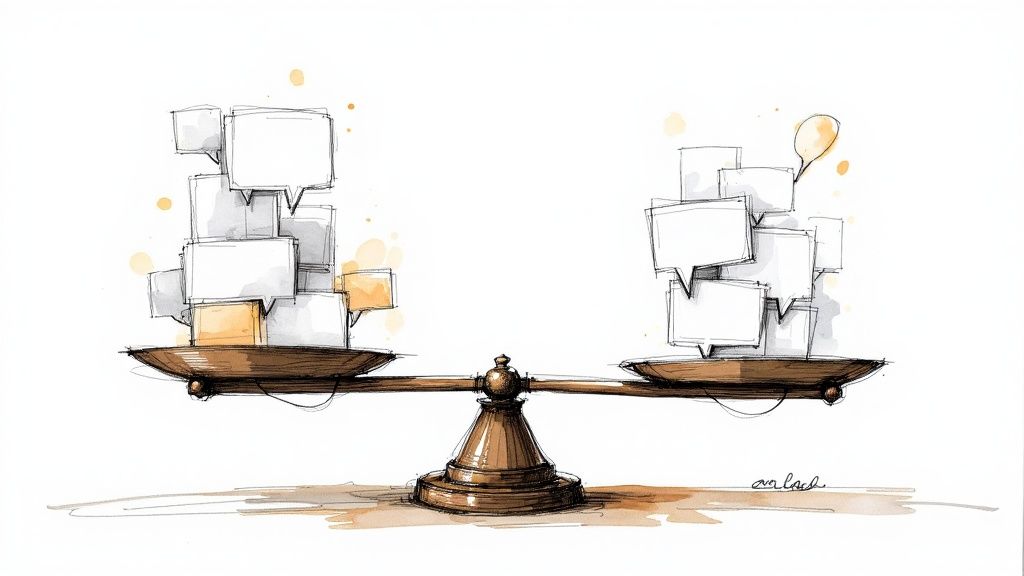10 Expert Online Reputation Management Tips: Strategic Guide For Modern Brands
Master your digital brand presence with battle-tested online reputation management tips from industry leaders. Discover actionable strategies that drive measurable improvements in your brand's online perception and authority.
- 8 min read

Understanding The Real Impact of Online Reviews
The numbers tell a clear story about how reviews shape buying decisions. 85% of consumers now put as much faith in online reviews as personal recommendations from friends and family. Even more striking, 80% of consumers will change their minds about a purchase after reading negative feedback, while 60% report that bad reviews stopped them from choosing a business. See more data here: Reputation Management Statistics.
Why Online Reviews Matter
Think about your own habits when picking a restaurant or buying a product - you likely check the reviews first. This behavior has reshaped how customers discover and choose businesses. Good reviews build trust and attract new customers, while negative ones can quickly drive people away, especially in competitive markets where buyers have many options.
Turning Reviews Into Opportunities
Smart companies don't just passively collect reviews - they actively use them to get better. Here's how successful businesses handle reviews:
- Ask for feedback: Reach out to happy customers and make it easy for them to share their experience
- Respond thoughtfully: Reply to both positive and negative reviews promptly and professionally
- Learn from patterns: Look for common themes in customer feedback to spot areas that need improvement
Responding To Negative Reviews
While no one likes getting negative reviews, they offer a chance to showcase great customer service. A thoughtful response shows you care about making things right and can even turn unhappy customers into loyal fans. Want to learn more? Check out: How to master customer reviews.
Case Studies and Frameworks
Looking at how other companies handle their online reputation provides practical lessons. By studying successful examples, businesses can develop better strategies for managing reviews and building trust with customers. The key is learning from others' experiences while creating an approach that fits your specific business needs.
Mastering Search Engine Visibility For Brand Protection

When customers search for your brand online, what they see shapes their perception. Taking control of your search results helps ensure they find accurate, positive information about your company. This goes beyond basic search optimization - it's about actively managing your brand's story.
Optimizing Content For Positive Brand Visibility
The key to strong search visibility is creating meaningful, well-optimized content. Think of search results as valuable real estate - you want to own as much of the first page as possible with content that truly represents your brand. Focus on authentic stories that matter to your audience.
Write blog posts and articles highlighting real customer success stories, company milestones, and community work. Fresh, quality content signals to search engines that your site is active and authoritative. Regular updates help maintain strong rankings over time. Most importantly, this positive content makes it harder for any negative mentions to gain visibility.
The Power of Google in Online Reputation
Search engines, especially Google, heavily influence how people perceive brands online. The numbers tell the story - Google handles 81.95% of desktop searches worldwide. The top result gets 31.7% of clicks, and 95% of users never look past page one. For deeper insights, check out these online reputation management statistics. Getting and staying on that first page is essential.
Building a Multi-Platform Presence
Your brand needs an active presence beyond just your website. Keep your profiles current on social media, review sites, and industry directories. Think of each platform as adding another positive result to search pages. When all your profiles share consistent messaging, it strengthens your overall brand image.
Ongoing Monitoring and Maintenance
Managing your online reputation requires constant attention, like tending a garden. Set up alerts to track brand mentions and regularly review search results. Respond promptly to reviews - both positive and negative. Create content that addresses customer questions and concerns. This active approach helps maintain a strong brand image and prepares you to handle any reputation challenges that arise.
Building A Strategic Social Media Presence That Resonates
Social media requires more than random posting - it's a valuable tool for online reputation management. A well-planned strategy helps establish authority, build trust, and guide how people view your brand. The key is creating content that truly connects with your followers.
Developing Platform-Specific Content Strategies
Each social media platform attracts different audiences and works best with specific content types. Good online reputation management means understanding these differences. For example, Instagram needs high-quality visuals, while Twitter works better with quick, engaging text updates. Knowing your audience and adjusting your content for each platform is essential.
- Instagram: Create eye-catching visuals that show your brand's authentic personality
- Twitter: Post timely updates and join relevant industry conversations
- Facebook: Grow your community through helpful content and follower engagement
- LinkedIn: Share expert insights and company updates to build credibility
Planning content with a calendar keeps posts consistent and helps reach the right people at the right time.
Managing Community Interactions at Scale
As your following grows, keeping up with comments and messages becomes more challenging. Quick, professional responses show your audience you care about their input. Social media management tools can help larger brands handle these interactions smoothly. Look for features that help track sentiment and monitor brand mentions.
Effectively Handling Social Media Crises
Social media problems can pop up without warning, and your response shapes your online reputation. Having a solid crisis management plan is essential. This means clear communication rules, choosing who speaks for your brand, and preparing messages for common issues. Being quick and honest helps rebuild trust when problems arise. Regular brand monitoring helps catch potential issues early.
Measuring the Impact of Social Media on Brand Perception
Tracking how well your social media works matters. Looking at follower growth, engagement, and reach shows how people respond to your content. Use this data to improve your strategy and create better posts. Watch what people say about your brand to understand public opinion. Regular review of these numbers helps maintain a positive online presence.
Creating Content That Shapes Brand Perception

Content is the heartbeat of your brand's online presence and a vital tool for managing your reputation. Each piece of content you create helps tell your brand's story and guides public perception. By developing thoughtful content, you can actively participate in conversations about your brand rather than just responding to them.
Building Authority Through Strategic Content
Creating high-quality, authoritative content helps establish your brand as a trusted industry voice. Consider developing:
- In-depth blog posts that showcase expertise
- Detailed white papers that present original research
- Practical webinars that solve real problems
- Step-by-step tutorials that help users succeed
This type of content naturally attracts mentions and links from other respected websites, which strengthens your credibility over time.
Engaging Your Audience With Compelling Stories
The best content forms an emotional connection with readers. Share authentic stories through:
- Customer success stories and testimonials
- Behind-the-scenes looks at your company culture
- Case studies highlighting real results
- Team member spotlights and interviews
When your content resonates on a personal level, people are more likely to share it with others. Learn more about building engagement through our guide on getting online reviews with email.
Mitigating Crises Through Proactive Communication
Being prepared for challenges is just as important as sharing positive content. Your crisis communication plan should include:
- Pre-written responses for common issues
- Clear protocols for handling negative feedback
- Trained team members ready to respond
- Guidelines for maintaining transparency
Having these pieces in place shows customers you take their concerns seriously and helps preserve trust during difficult times.
Building a Cohesive Content Ecosystem
Your content strategy works best when all pieces support each other. Focus on:
- Consistent messaging across all platforms
- Content tailored for different channels
- Regular updates to keep information fresh
- Measuring and adjusting based on results
When your content works together as a system, it creates a strong foundation for managing your online reputation and building lasting relationships with your audience.
Implementing Proactive Crisis Management Protocols

A strong crisis management strategy helps protect your online reputation before issues arise. By studying how other companies handle challenges, you can build effective systems to address problems quickly when they occur. This proactive approach is far more effective than simply reacting after issues emerge.
Developing a Crisis Response Framework
Think of your crisis response framework as an emergency response plan for your brand's reputation. Just like a fire drill, it maps out exactly what needs to happen when problems arise. Having clear protocols prevents confusion and enables swift action.
Key elements to include:
- Map out likely crisis scenarios that could affect your brand
- Create clear guidelines for official company communications
- Build a master contact list of stakeholders, team members, and media contacts
Remember to review and update this framework regularly as your business grows and changes.
Establishing Effective Monitoring Systems
Catching potential issues early is vital for protecting your online reputation. Setting up thorough monitoring helps you spot concerning trends before they become major problems. You might be interested in: Best way to get online reviews & testimonials.
Essential monitoring elements:
- Track mentions of your brand across social media and review sites
- Watch for shifts in customer sentiment and feedback
- Set up instant alerts for spikes in negative comments
Quick detection allows for prompt response and reduced impact on your reputation.
Training Teams for Rapid Response
Your team needs to know exactly what to do when reputation issues arise. Regular practice ensures everyone understands their role and can act quickly under pressure.
Key training components:
- Practice crisis scenarios to test response procedures
- Train staff in clear, empathetic customer communication
- Give team members appropriate authority to take action
Well-prepared teams handle challenges more effectively and maintain customer trust.
Turning Threats Into Opportunities
When handled well, reputation challenges can actually strengthen customer relationships. Being open and honest while taking clear action to fix problems shows customers you care. A thoughtful response that aligns with your values can build deeper trust and even attract new customers who appreciate your commitment to making things right.
Measuring And Monitoring Reputation Impact

Managing your online reputation requires careful tracking and analysis. Instead of just reacting to issues, successful brands take a data-driven approach to understand and shape their online presence. By gathering detailed insights, you can spot potential problems early and address them before they grow.
Quantitative Metrics: Measuring the Measurable
The foundation of reputation monitoring starts with tracking key numbers that show how your brand performs online:
- Star Ratings: Average scores from review sites
- Review Volume: Total number of positive and negative reviews
- Social Media Stats: Number of likes, shares, and comments
- Website Traffic: Visitor numbers, especially from search results
These metrics help paint a clear picture of your reputation's health over time.
Qualitative Indicators: Reading Between the Lines
Numbers tell only part of the story. The actual content of reviews and comments reveals deeper insights about how customers view your brand. By analyzing review text and social conversations, you can uncover common themes and issues. Watch for changes in how people talk about your brand - shifts in tone or language often signal growing concerns.
The Role of AI in Reputation Monitoring
Modern reputation management tools use AI analysis to process large amounts of online data. These systems can automatically:
- Sort reviews by topic and sentiment
- Spot emerging trends
- Flag potential reputation risks
- Free up staff time for strategic work
This helps teams respond faster to both opportunities and challenges.
Establishing Meaningful KPIs
Choose Key Performance Indicators (KPIs) that directly connect to your business goals. For example, if you want to improve customer satisfaction, track:
- Changes in average review ratings
- Number of positive vs negative reviews
- Response time to customer feedback
Clear KPIs help measure progress and show where you need to focus.
Creating Effective Reporting Systems
Raw data needs context to be useful. Build simple, regular reports that:
- Summarize key metrics
- Highlight important trends
- Show progress toward goals
- Make insights clear to everyone
Good reporting keeps your team informed and aligned on reputation priorities.
Ready to take control of your online reputation? kisReviews offers powerful tools to simplify review management, monitor brand mentions, and build a stronger online presence. Learn more and start your free trial today!
